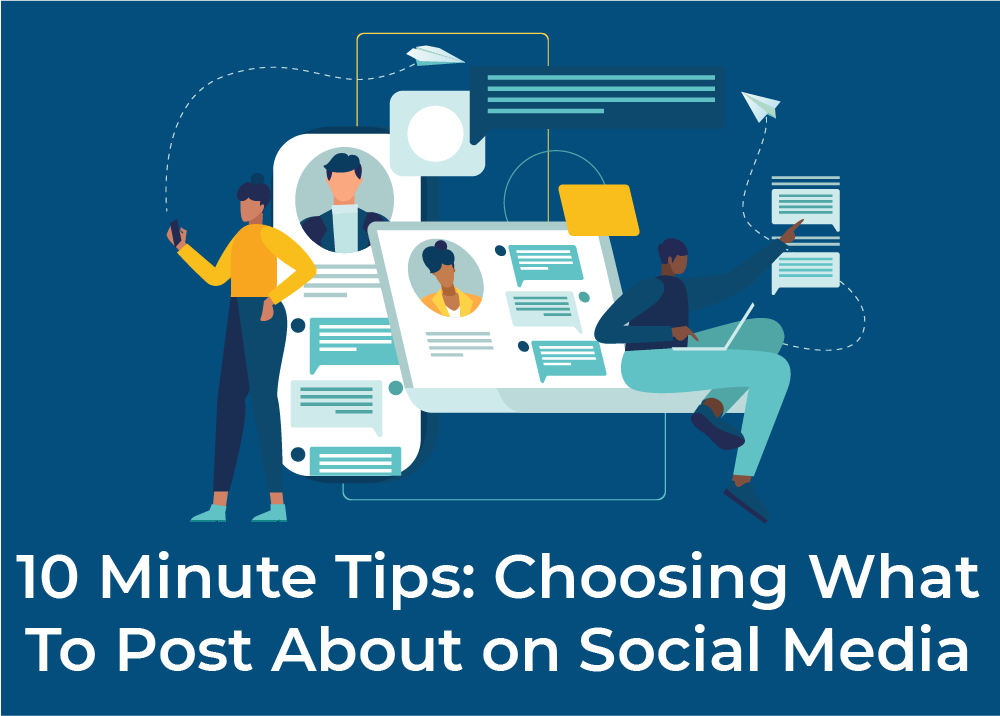” Remember that the key to everything is consistency, and playing smarter and not harder.”
Have a question? Ask us today!
If your business has limited resources in it’s marketing department, it can be difficult to not only keep up with marketing activities, but to keep a laser focus on engaging with activities that are building towards the bigger picture in your campaigns.
One impactful component of this is your content schedule for social media. Social media is a place that I often see our clients struggle to be consistent. It isn’t uncommon to leave behind social media activities for higher-priority activities, but they are important for maintaining a connection with your regular audiences, bringing in new clients, as well as maintaining a pulse to keep your business on the map.
On the other side of not posting enough, we’ve also seen companies that are very engaged with social media, but will be posting without the bigger picture in mind and not keeping track of their larger goals. This will sometimes result in them posting in large quantities, but without connecting their visitors to their website, not tracking who is coming from where, or not posting content that is attractive and beneficial to their viewers.
Depending on your business model, social media may or may not be a large component of how you interact with your target audiences. But it is still an important component of your overall strategy to maintain as often as your team has the time for.
So how do we create a sustainable way to create social media content even with limited resources?
The first place to start is analyzing your business. Unfortunately, with marketing, there is not one answer, all of the different components of your marketing strategy will interact with each other in different ways depending on your industry, size, audience, and services.
In order to identify your needs, first think about what the ideal action you want your audience to take online is – that will be the baseline for at least half of your content. Do you need them to request a demo? Maybe you need them to schedule time to talk to you face or face. Or, if you have a product you are selling online, you ideally want them to simply purchase that product when they interact with you.
By singling out that action, or conversion, you want your audience to take we can build a framework of developing content around that action and then bolster it with additional content to create a space for engagement and resources that are valuable to your preferred viewers.
Let’s work around an example
I work a lot better with concrete examples, so let’s take a hypothetical business. Let’s say that the business we are working with is a zero-waste brick and mortar business that sells locally sourced grains to ethically minded individuals.
As a brick and mortar business, we don’t want to sell to people online, we want them to come into the store. So the action that we want our hypothetical audience to take is to 1) talk to local people who can come into the business location, and 2) draw those people in to encourage them to come to the store itself.
So our action is that we want the audience to come to the store’s physical location. Great! Let’s move on.
After we identify the action we want our audience to take, it’s time to brainstorm posting ideas that will encourage that action
Since we want people to physically enter the store, we can develop a content plan that centers around bringing people into the store. Off the bat, this can include posts like coupons for people to save money coming into the store, announcements of a new partner whose local grains are being brought into the store, add images of interesting items you have in stock, videos about how the zero waste process works in your store, and maybe some blog posts about the zero waste movement and how the business is helping contribute towards furthering it.
After we’ve come up with some options, you have to look at your resources and how much time you have available. The easiest way to stay on top of your social media is to create a longer term calendar that spans across a few months so you can see the big picture view of your strategy. Every business has different amounts of times to post, depending on your audience, you may need to post every day, or a few times a week but you will log them all in your calendar regardless.
We generally recommend starting out with 2-3 posts a week, and testing with more and less posts as you gain an audience. Look across the few months that you are building across and start by logging relevant holidays to your business – use this as a baseline for pulse posts and then see which weeks you still need a concept for the remaining 2 or 3 posts. This can help businesses that struggle with posting to make it only a couple times a week, as a way to slowly build up to developing more content. Then you want to make sure that at least one of your posts a week is driving towards that target action – you don’t want your content to come across as one long sales pitch but you do still need to drive towards your end goals for keeping your business running. Finally fill in the remaining content with helpful information – for our earlier example it could be those posts about the zero waste industry at large, company culture content, good ways to store your goods once they’re back home, or recipes that can be made with the unique ingredients from your shop. If people feel they are learning useful things from you – they’re more likely to stick around as a long term visitor.
With these processes, and by working ahead of time it can be a lot easier to come up with your posts concepts since you know exactly what you’re missing as you draft content. Before trying to build up a very active posting schedule, just maintain a lighter one consistently to build it into your daily habits or keeping things running.
After that is testing, testing, and more testing
As you get a better handle on maintaining a consistent schedule, it’s time to optimize. Based on your customers reaction to content, and by tracking what is happening (You can learn more about tracking using UTM codes in our blog about that!), you can start to tailor your content to your audience. Play with posting more, play with posting at different times, and from that you’ll be able to design a way to post in a way that works with your audience. Remember that the key to everything is consistency, and playing smarter and not harder. We’ll talk soon about ways to make the most out of all your content, and different ways you can post to different platforms by utilizing different aspects of your content! If you have any questions about how your business could specifically improve your social media, feel free to reach out today at [email protected], and we’d be happy to chat with you about some quick ideas to optimize your content strategy!






